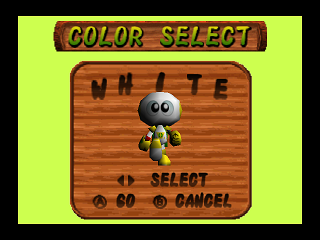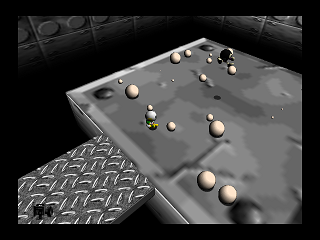Chameleon Twist
| Chameleon Twist |
|---|
|
Developer: Japan System Supply
|
Chameleon Twist is a short game starring four alleged-chameleons that followed a White Rabbit to a strange world. Then they just start beating up everything in sight...
| To do: Hidden Palace released a late prototype of Wipeout 64 that contains an overdump of a Chameleon Twist prototype near the end. Find a way to look through the remnants for anything. |
Contents
Unused Shoe Monster
This odd shoe monster has a full set of animations for each angle, like the rest of the enemies in the game.
Uncompiled Source Code
At 0xF4B6C in the US ROM, the following code fragment for the credits can be seen. Note that this uses EUC-JP encoding.
#include<ultra64.h>
#include"SUGI/demodata.h"
DEMO_KEY DemoData%s[] = {
};
#if fgDEMO == 1
static int SIview_data = 0;
static int SIroll_data = 0;
static int SIeffe_data = 0;
VIEW_DATA view_data[mxVIEWCAT];
ROLL_DATA roll_data[mxROLLCAT]={
{0,0 ,0,0,"EXECUTIVE PRODUCER","KATSUMI","KAWAMURA","","","",""},
{0,1 ,0,0," PRODUCER","TAEKO","NAGATA","","","",""},
{0,2 ,0,0,"GAME DESIGN","HIDEYUKI","NAKANISHI","","","",""},
{0,3 ,0,0," DIRECTOR","MASAKI","KIMURA","","","",""},
{0,4 ,0,0,"COMPUTER ARTS","TAKASHI","MAKINO","YUKI","TAMURA","HIROYUKI","MORIOKA"},
{0,5 ,0,0," PROGRAM","HIDEYUKI","NAKANISHI","MASATAKA","IMURA","TAKASHI","SUGIOKA"},
{0,6 ,0,0," PROGRAM","MASAKI","KIMURA","MASAOMI","ISHIMOTO","",""},
{0,7 ,0,0,"GRAPHIC ARTS","MITSUYASU","NOMOTO","HIDEKI","SHIBAGAKI",
"",""},
{0,8 ,0,0,"MUSIC & SOUND","TAKASHI","SUGIOKA","TAKASHI","MAKINO","YUUJI","NAKAO"},
{0,9 ,0,0,"MUSIC & SOUND","NOBUTOSHI","ICHIMIYA","KOKI","TOCHIO","TSUTOMU","WASHIJIMA"},
{0,10,0,0,"MUSIC & SOUND","HIROSHI","TAKAMI","FUMIHIKO","YAMADA","",""},
{0,11,0,0,"DEBUGGING TEAM","YUUSUKE","TABATA","SHINGO","MATSUMURA","MAKOTO","MAEHIRA"},
{0,12,0,0,"ORIGINAL CHAMELEON DESIGN","TADASHI","OHYA","","","",""},
{0,13,0,0," GAME DESIGN","HIDEYUKI","NAKANISHI","TAKASHI","MAKINO","YUKI","TAMURA"},
{0,14,0,0," GAME DESIGN","HIROYUKI","MORIOKA","MAKOTO","TANAKA","",""},
{0,15,0,0," GAME DESIGN","AI","NADATANI","AKIROT","","",""},
{0,16,0,0,"ASSISTANT PRODUCER","SHYOJI","OGAWA","","","",""},
{0,17,0,0,"PUBLIC INFORMATION","YUKAKO","OKADA","SACHIYO","NOGAMI",
"",""},
{0,18,0,0,"SPECIAL THANKS TO","SUPER MARIO CLUB","","FAMIMAGA64","","",""},
{0,19,0,0,"PRESENTED BY C1996","JAPAN SYSTEM SUPPLY","","","","",""},
};
EFFE_DATA effe_data[mxEFFECAT];
#else
/*----------------------------------------------------------------------------------*/
/*----------------------------------------------------------------------------------*/
/*----------------------------------------------------------------------------------*/
static int SIview_data = %d;
static int SIroll_data = %d;
static int SIeffe_data = %d;
static VIEW_DATA view_data[mxVIEWCAT] = {
{
%d,
%d,
%d,
{
%d, }, {
%d, }, {
%d, },
%d,
}
};
static ROLL_DATA roll_data[mxROLLCAT]={
{
%d,
%d,
%d,
%d,
"%s",
"%s",
"%s",
"%s",
"%s",
"%s",
"%s",
},
};
static EFFE_DATA effe_data[mxEFFECAT] = {
};
#endif
ON STOP バッファがない
データ読み込み失敗
ON STOP PAUSE
#include<ultra64.h>
#include"SUGI/demodata.h"
DEMO_KEY endingData[] = {
};
バッファがない
データ読み込み失敗
#include<ultra64.h>
#include"SUGI/demodata.h"
The Japanese text present in this code translates to:
| Japanese | Translation |
|---|---|
| ON STOP バッファがない | ON STOP No buffer present. |
| バッファがない
データ読み込み失敗 |
No buffer present. Data load failed. |
Regional Differences
Apparently, Japan kept all the good stuff for themselves. The international releases seem positively unfinished in comparison!
General Differences
- In the international releases, the Sunsoft logo appears before the Japan System Supply Logo. It's absent in the Japanese release.
- Battle Mode cannot be entered with one player in the international releases. In Japan, however, one player can enter to play against CPU players.
- Despite this, the "COM PLAYER NUM" option from the JP version is still present in Rev A, or US version 1.1. By pressing Left or Right while hovering over the "EXIT" button in battle mode's options, extra CPUs can be added.
- Throughout the levels, powerups are placed in areas where they may be useful. In the international releases, these powerups are only present in Battle Mode. The powerups are:
- A black, pentagonal shape that causes the chameleons' heads to grow, enlarging the enemies they spit out as ammo.
- A red ball surrounded by three triangular shapes. This makes the chameleons shrink down. This is mainly used to get into small spaces.
- A stopwatch, similar to the one the White Rabbit uses. This freezes all enemies in the room for a small amount of time. This powerup is nowhere in the international releases.
- The White Rabbit greets the player before meeting every boss and gives them small hints on how to defeat them. This was brought back in Chameleon Twist 2.
- There are now five Carrots to collect. These will allow the chameleons into mini-games and secret areas. This feature was also brought back for the sequel.
- The boss of Bomb Land drops bombs much faster.
Memory Pak Warning
In the non-Japanese versions, if you start the game with a Memory Pak inserted, you'll receive a warning message. This message does not appear in the Japanese version.
Level Layout
Some levels have had drastic modifications to their layout.
Ant Land
| International | Japan |
|---|---|
 |
 |
In the fourth room you can go into, there is a ring of crowns surrounding a single orange Heart in the international releases. This was replaced with an area full of rising platforms, wooden poles, and marching Ants in the Japanese release.
| International | Japan |
|---|---|
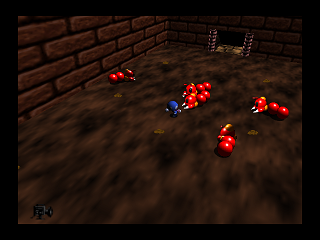 |
 |
In the large room filled with worms, the international releases got... a large room filled with worms. Meanwhile, Japan got two seesaw-like platforms and two crowns. It also has a slightly different floor texture. The worms' mud mounds that signal where they will pop up were also removed in Japan.
| International | Japan |
|---|---|
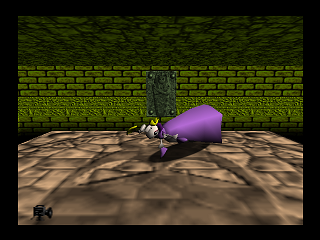 |
 |
The fight against the Ant Queen now features a health display. Also, the Japanese release moved the ceiling higher up, for whatever reason.
Desert Castle
| International | Japan |
|---|---|
 |
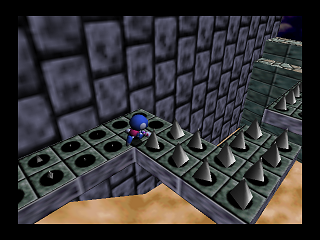 |
The first spike platforms the player encounters are made up of two straight platforms in the international releases. Japan made a decidedly less straight path for their spikes.
Like the Ant Land boss, the Desert Castle boss has also been given a health display.
Kids Land
| International | Japan |
|---|---|
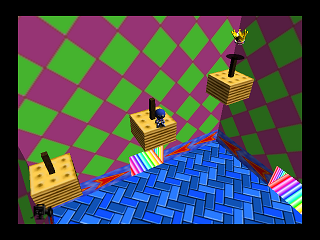 |
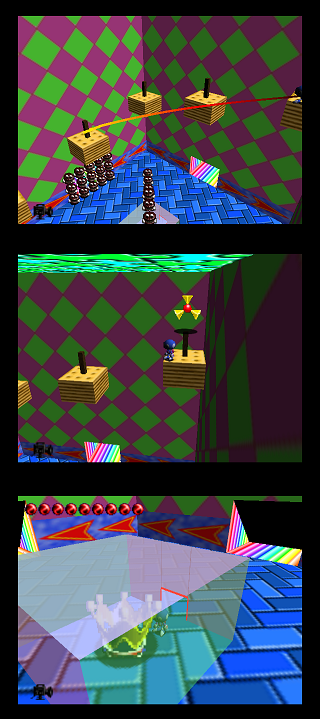 |
In the fourth room, there are three platforms and a crown in the international releases. In Japan, there is a swarm of ice cream sandwiches, a glass box with a crown in it, and five platforms. After all of the ice cream sandwiches are destroyed, a shrinking powerup appears on the fifth platform. The player can now go into the box to get the crown. If the player is still in the box when the powerup wears off, the box shatters.
| International | Japan |
|---|---|
 |
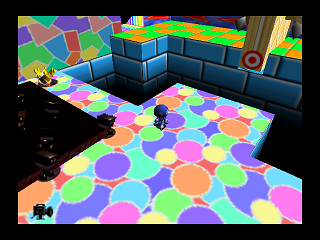 |
The fifth room has also been modified: In the international releases, there is a large stack of crackers leading up to a tall wall with a wafer creature waiting to be hit. In Japan, the wall is much shorter and the crackers have been replaced with a pit. In the third room with wafer monsters, the exact same modifications have been made.
The most significant difference, however, is the addition of a bowling minigame. In the area with three platforms encircling a wooden pole, the White Rabbit is standing by a door. If you have a certain number of carrots, he will let you pass through to play the game. This area is like the bowling game in Chameleon Twist 2, but you can't position the ball, making it significantly harder. If you get enough points, a crown will appear in the room. The pins will also take on the appearance of the player's chameleon, just as it does in Chameleon Twist 2.
Ghost Castle
| International | Japan |
|---|---|
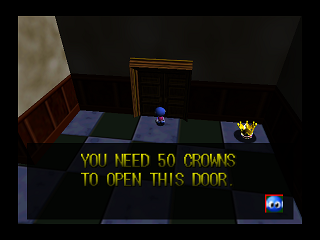 |
 |
The entrance to the Pool mini-game has been moved. In the international releases, it was set right near the level's entrance. In Japan, it was set in one of the early rooms, with the White Rabbit standing right outside.
....? (Boss Rush Stage)
In the international releases, there is no difference between the bosses' fights in their stages and in this stage. However, Japan made the Boss Rush battles much more challenging than in their stages. All of the bosses have been made faster, stronger, and mind-bendingly harder to beat.
White and Black
After beating the game once, a white chameleon is unlocked. This chameleon is aptly named White. White has no abilities or quirks that set him apart from the other chameleons. He's just... white.
There is also a black chameleon to unlock. This chameleon is named, of course, Black. Unlocking him is not as easily done as White.
In Bomb Land, there is a barred doorway, guarded by the White Rabbit. To get past the bars, the player must collect all five carrots from the game. Through the door is a small arena, with Black standing in the middle. The player must defeat Black to get a crown. After his defeat, he is unlocked for Battle Mode, but not Story Mode. Black cannot be unlocked as playable for Story Mode, perhaps to keep from having Black face off against himself, though he can easily be hacked into Story Mode.
Ending
In the Japanese version, when the last boss dies the player's chameleon escapes through a narrow hallway before showing the credits. In the international versions, the screen fades out to the credits directly.
Perfect Code
| To do: Find out what this code does. |
After beating the game once, a new challenge appears: After starting a new game with White, a star is put in the corner of the screen. If the player gets hurt even once during the course of the entire game, the star goes away. However, if the player is not hurt once throughout the entire game, the game will show a special "Perfect Code" after the credits roll and on the title screen.
At this time, it is unknown what the code does, if anything.
- Pages missing developer references
- Games developed by Japan System Supply
- Pages missing publisher references
- Games published by Sunsoft
- Games published by Japan System Supply
- Nintendo 64 games
- Pages missing date references
- Games released in 1997
- Games released in December
- Games released on December 12
- Games released in November
- Games released on November 30
- Games released on December 6
- Games with uncompiled source code
- Games with unused enemies
- Games with regional differences
- Pages with a Data Crystal link
- To do
Cleanup > Pages missing date references
Cleanup > Pages missing developer references
Cleanup > Pages missing publisher references
Cleanup > To do
Games > Games by content > Games with regional differences
Games > Games by content > Games with uncompiled source code
Games > Games by content > Games with unused enemies
Games > Games by content > Pages with a Data Crystal link
Games > Games by developer > Games developed by Japan System Supply
Games > Games by platform > Nintendo 64 games
Games > Games by publisher > Games published by Japan System Supply
Games > Games by publisher > Games published by Sunsoft
Games > Games by release date > Games released in 1997
Games > Games by release date > Games released in December
Games > Games by release date > Games released in December > Games released on December 12
Games > Games by release date > Games released in December > Games released on December 6
Games > Games by release date > Games released in November
Games > Games by release date > Games released in November > Games released on November 30





